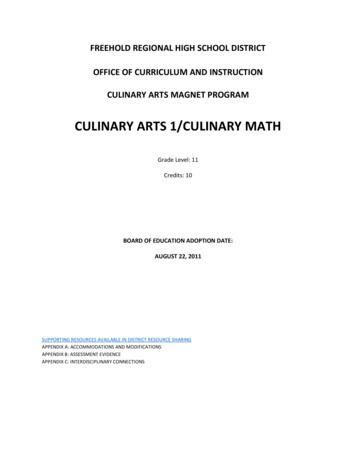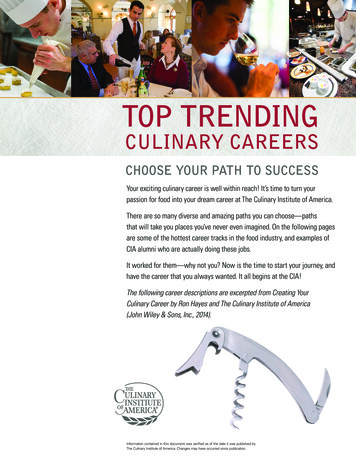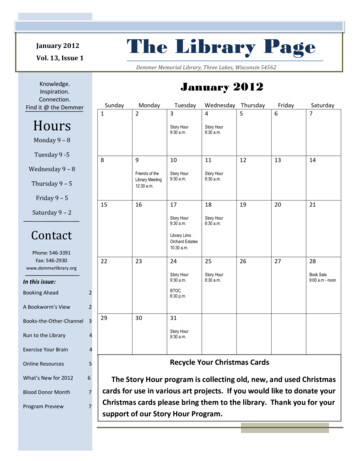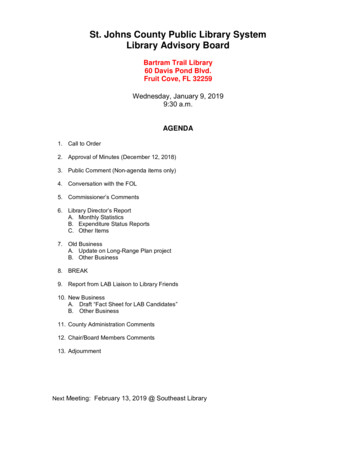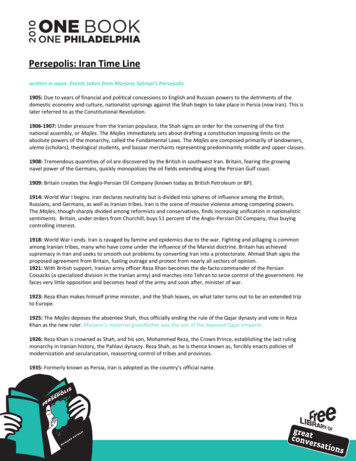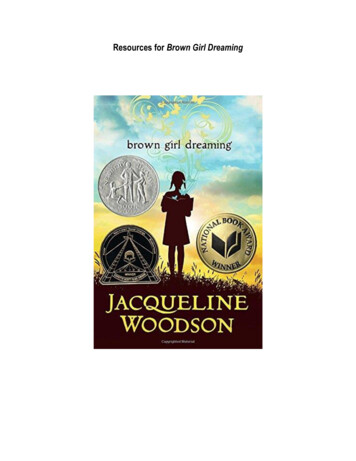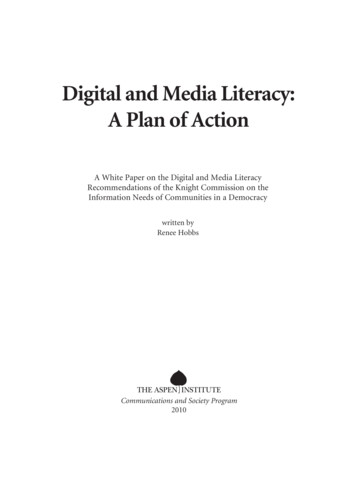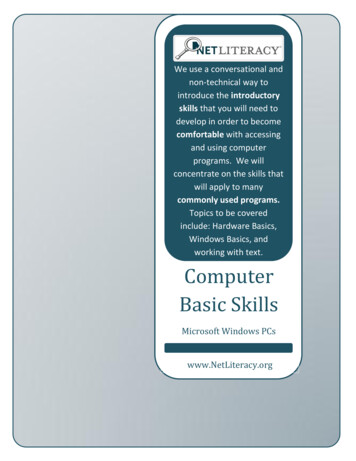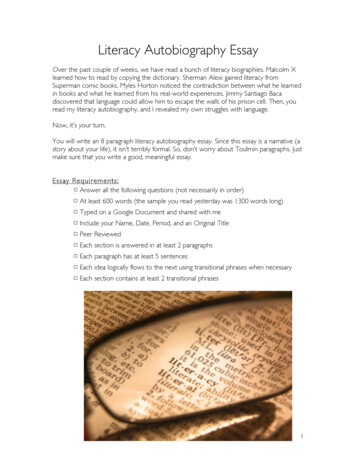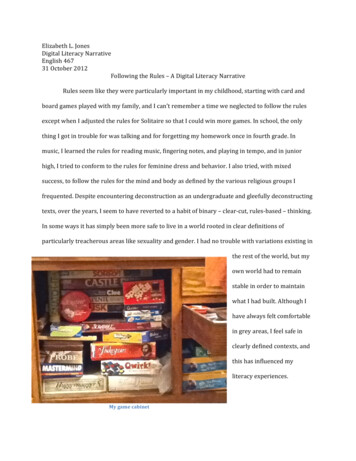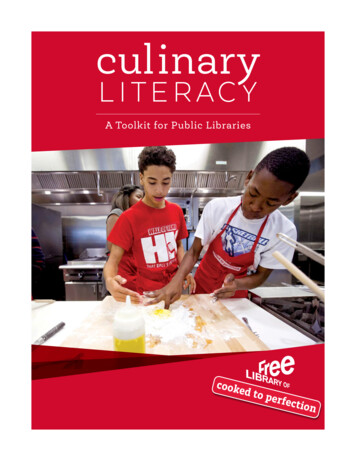
Transcription
culinaryL I T E R AC YA Toolkit for Public Libraries
ContentsInspiration and Origin.3A Note from the Culinary Literacy Center Administrator.4Advocacy: Making the Case for Culinary Literacy.5Fundraising.6Space and Equipment Options.7Safety.9Food Procurement.11Community Partners.12Programming.13Resources. 15
Inspiration and OriginThe Culinary Literacy Center is the first kitchenclassroom in a public library in the United Statesof America. The Culinary Literacy Center wasthe brainchild of the President and Directorof the Free Library of Philadelphia, SiobhanReardon. It was builtThe missionas part of renovationsto the Parkway Centralof the FreeLibrary, the flagshipLibrary oflocation of the FreePhiladelphiaLibrary. The missionof the Free Libraryis to advanceof Philadelphia is toliteracy, guide advance literacy, guidelearning,learning, and inspirecuriosity. Under theand inspirevisionary leadership ofcuriosity.Ms. Reardon, the FreeLibrary has committedto supporting its mission through innovationand creativity.Siobhan Reardon in the Culinary Literacy Center withAdministrator Elizabeth Fitzgerald.Photo 2015 Jon Roemer, Librar y Journa lThe Culinary Literacy Center was created with the understanding that cooking and eating are educationalacts. According to Ms. Reardon, Library Journal ’s 2015 Librarian of the Year, “Nothing is more literacybased than cooking. It is all basic literacy, math, and science. It is tactile learning, and it is social.” Food andcooking present many opportunities to advance literacy: reading a recipe andThe missionunderstanding the vocabulary of the ingredients and cooking tools, knowingthe math of measurements and how to scale a recipe up or down, studying theof the Culinaryscience of cooking and growing food, understanding the connection betweenLiteracy Centerour health and the food that we eat, and exploring culture and history throughis to advancecuisine. With 54 neighborhood libraries throughout the city, the Free Libraryof Philadelphia is the heart of every Philadelphia community. Cooking andliteracyeating provide ample opportunity to build and sustain community. The Culinarythrough foodLiteracy Center brings Philadelphians of all backgrounds together to learn andand cookinghave fun around a shared experience.The mission of the Culinary Literacy Center is to advance literacy through foodand cooking around a communal table. We are a center in the Free Librarythat serves Philadelphians of all ages, from pregnant mothers and preschoolstudents to senior citizens, and we function as a unique gateway to the library.around acommunaltable.freelibrary.org/cook 3
A Note from the Culinary LiteracyCenter AdministratorSince opening the Culinary Literacy Center in June 2014, libraries and community centers from around thecountry and world have contacted us to learn how to bring culinary literacy to their communities. We arethrilled to be sharing our story, and this toolkit, with library leaders and innovators.The answers we give now are different from the ones we gave in the beginning and reflect our own journey.The early days of the Culinary Literacy Center involved a lot of throwing pasta at the wall to see if it stuck,which meant trying so many different things out. We knew what it meant to be librarians, but weren’t so sureabout how to open a cooking school or a restaurant, which was what it felt like we were doing some days.We were inventing what it meant to do culinary literacy programming in a library. It was exciting and a littleterrifying. The biggest difference between now and then—besides the size of our staff—is that now we relymuch less on our partners to determine what our programming looks like. We found our voice. We definedour mission.DEFINE THE MISSION: That is the best piece of advice I have to give whenspeaking with the people who contact us to learn about how to open a kitchen inusing thetheir library. I ask people to tell me: What is it you want to do? Why do you wantcooperativeto bring culinary literacy to your community? Who are you hoping to serve?nature ofOnce you know that, you can begin to identify programs to create, organizationswith which to partner, materials to share, library resources to tie in. I can, and will,cookingtell anyone who wants to know what it cost to build the space, how many mixingto buildbowls and spoons to have on hand, the quantity of towels you’ll need each week,community.how to order food, what kinds of organizations make the best partners. You’llfind much of that in this toolkit. It will be inordinately useful to have insight onthe logistics of running the Free Library’s Culinary Literacy Center, the hows of the program. My challengeto you is to think strategically on the whys. For us, the answer is to advance literacy through food andcooking around a communal table. By that, we mean learning through cooking and learning aboutcooking , which is how we define culinary literacy. It means using the cooperative nature of cooking to buildcommunity. It means being a space that elevates hands-on, project-based learning, that celebrates diversity,that is open and inclusive.I look forward to hearing what culinary literacy programming means to you.Cheers,Liz FitzgeraldAdministrator, Culinary Literacy Center, June 20174 freelibrary.org/cook
Advocacy: Making the Case forCulinary LiteracyCooking is a vehicle for strengthening math skills.1A plant-based diet can improve health.2Using data to support statements like those above can strengthen your proposal and help you get thesupport you need from your library’s administration and board. To help make the case for how culinaryliteracy programming can advance literacy, improve community health, and support your library’s mission,please consider the following benefits.Advancing Multiple LiteraciesAt the Culinary Literacy Center we advance multiple literacies through cooking. In our Edible Alphabetclass, students learn English in our kitchen classroom. In her book How to Bake Pi, Dr. Eugenia Cheng, atheoretical mathematician, explains math concepts through cooking. Library users can read nutrition labels,mix math and cooking , and explore the science of cooking. There is also the importance of a communitybased understanding of food literacy. Your program can guide learning about the hands that feed us,cultural foodways, environmentally sustainable eating, and food insecurity in your community. What willyour visitors learn in your library’s culinary literacy program?Improving Community HealthThe Pew Research Center’s report Libraries at the Crossroads found that library users “view publiclibraries as important resources for finding health information” and that “73% of all those ages 16 and oversay libraries contribute to people finding the health information they need.” Find information about yourcommunity’s health needs and let what you learn guide your programming. Look for government resourceslike the Centers for Disease Control and Prevention’s Nutrition, Physical Activity, and Obesity: Data,Trends and Maps—which provides information about the health status and behaviors of Americans, stateby-state, via clickable maps, charts, and tables—and Eurostat’s Health in the European Union – facts andfigures, which provides recent statistics on health in the E.U., focusing on areas like health status, healthdeterminants, and health care. For a global perspective, explore the World Health Organization’s NutritionLandscape Information System, the Global Nutrition Report, or the Institute for Health Metrics andEvaluation. Zoom in, if data is available, to look for local information about your city. We use the City ofPhiladelphia’s Community Health Explorer, which includes important indicators like low-to-no walkableaccess to healthy foods and Philadelphians living in poverty.RESOURCES1. The calculus of do(ugh)nuts. cheng.staff.shef.ac.uk/misc/cheng-doughnuts.pdf2. Vegetarian Diets Linked to Lower Mortality. n-diets-linked-lower-mortalityfreelibrary.org/cook 5
FundraisingBuilding the Culinary Literacy Center cost a total of 1.2 million dollars. The funds for this construction projectwere procured from a public–private venture combining contributions from the City of Philadelphia with arobust fundraising campaign from the Free Library of Philadelphia Foundation. The Foundation continuesto raise money for Culinary Literacy Center programming through grants, sponsorships, private donations,ticket sales, and program fees.While many of the programs at the Culinary Literacy Center are free, we charge a small fee—from 5 to 35per person—for some programs, which goes toward covering the cost of ingredients and other programmaterials.Nutrition, health, and food access are currently popular subjects for grant funding. We have been successfulsecuring funding from small family foundations. For your program, look for funding through local grocerystore chains and hospitals. Check out larger, regional, and national corporate foundations. Ask your libraryfriends’ group or a local politician’s office to invest in your culinary literacy programming.6 freelibrary.org/cook
Space and Equipment OptionsWhat kind of space and tools will you need for your culinary literacy program? Here are kitchen space andequipment options for three different budgets.1. Commercial-Grade KitchenOur culinary kitchen and classroom space is approximately 1,700 square feet. Our restrooms and lockerarea is an additional 250 square feet; the office is 200 square feet; and the terrace, where we have a smallcontainer garden of herbs, is approximately 800 square feet.Our commercial-grade equipment includes 16 burners, 4 convection ovens, 2 salamanders (cheese melters),a grill top, a walk-in refrigerator, 4 reach-in refrigerators, a freezer drawer, an ice maker, and a large prep tableat the front of the classroom that has a sink and 4 of the burners on it. There is also a scullery, or dishwashingroom.The classroom area seats 36 people at 9 high stainless-steel work tables. We have three cameras that feed toa large-screen TV at the front of the classroom, giving every one of the 36 seats a view to what the instructoris doing. We often use the camera’s zoom feature, so students in the back of the room can see the details ofa small culinary technique, like the dicing of onions. Technological capabilities also include a sound systemand the capability to record programming and to stream a live feed.2. Mobile Kitchen UnitLibraries across the U.S. are exploring culinary literacy programming using mobile kitchens. The CamdenCounty Library system in New Jersey uses a mobile kitchen in its Books and Cooks program. The kitchenis complemented by a collection of books about nutrition, healthy eating, and consumer literacy. CamdenCounty transports the kitchen to its eight neighborhood libraries and other community locations todemonstrate cooking techniques and recipes. The San Francisco Public Library rolls the Biblio Bistro out tofarmers’ markets and library branches for culinary literacy programming.The Culinary Literacy Center has recently purchased a Charlie Cart, a mobile kitchen-classroom that comeswith kitchen tools and a hands-on, multidisciplinary nutrition-education curriculum for children.3. Kitchen in a BoxYou do not need a commercial-grade kitchen, or even a mobile kitchen unit, to offer culinary literacyprogramming in your library. If your budget is tight, the only things you need are a table, an outlet, runningwater, and the most basic cooking tools. Ideally, you would have meeting-room space. We use a Kitchen in aBox to offer culinary literacy programming at our neighborhood libraries throughout the city of Philadelphia.All of the kitchen tools, including an electric skillet and an immersion blender, fit inside of a large liddedplastic storage bin, which we can transport through our interlibrary mail system. The cost of a deluxe Kitchenin a Box kit is approximately 800 for a fairly exhaustive list of equipment, listed below. We have also workedsuccessfully with a smaller, less robust inventory list, which cost approximately 350 to compile.freelibrary.org/cook 7
Kitchen in a Box Equipment List(units per kitchen)10161113312111211111133112222202020111118 freelibrary.org/cookcutting matssharp chef’s knifegreen lettuce knivesbig heat safe spoonfood scissorscolandersets of measuring cupssets of measuring spoonscan openerquesadilla cutterstongspatulapotato masherliquid-measuring cupwhiskelectric skilletcitrus juiceregg suitcaseblenderset of 6 metal bowlssets of peelerssets of paring knivesset of knife coversgraterbench scrapershalf sheet baking pan/sheetmetal spoonssmall rolling pinsbutter knivesmetal forksspoonspitchertableclothextension cordcanister of sanitizing wipesbottle of cleaning spraypaper towels
SafetyOne of the biggest concerns with any cooking program is safety. People have questions about giving knivesto the public and how we keep from contaminating the food we prepare and eat. We take safety veryseriously at the Culinary Literacy Center. Here are some of the safeguards we employ to protect our visitorsand our staff.City Government Licenses and CertificationsThe Culinary Literacy Center is certified by the city of Philadelphia’s Department of Public Health as aDemonstration Kitchen. We are licensed for Food Preparing and Serving by the Philadelphia Department ofLicenses & Inspections. We are subject to routine, unannounced food-facility inspections conducted bythe Environmental Health Services division of the Department of Public Health. Most inspections occur oncea year, and inspectors stress the prevention of foodborne illness and the education of our staff on properfood-handling techniques. At the end of the inspection, the sanitarian gives us a report that itemizes anyfood-safety violations and explains how to correct them. Environmental Health Services has the authorityto order an establishment closed if it poses an imminent health hazard. Our kitchen also follows stringentfire codes, to help ensure a safe environment for cooking with industrial-grade equipment. Contact yourlocal fire department to better understand what it means to be in compliance with the fire codes in yourarea. Philadelphia provides this instruction manual that serves as a guide to permits and licenses related toopening a stationary food business in the city of Philadelphia. Contact your city government to learn moreabout the laws and regulations around opening a kitchen classroom in your library.ServSafeTo support our compliance with health regulations, to be informed food handlers, and to help keep ourcommunity safe, the staff members of the Culinary Literacy Center are all ServSafe certified. ServSafe is atraining program developed by the National Restaurant Association that offers food- and alcohol-safetytraining and certification exams. All of the Culinary Literacy Center’s staff members are certified at eitherthe ServSafe Food Handler or ServSafe Manager levels. We are moving toward a policy of having all of ourinstructors certified as Food Handlers, which costs 15. If your library is outside of the U.S, consider the FoodSafety and Quality trainings available from NSF International.Food SafetyProper handwashing technique is the most important way to prevent the spread of germs to others.Practicing as well as teaching this technique is the backbone of our programming. Our kitchen has threedesignated handwashing stations, and when we offer programs in our neighborhood libraries, we make surepeople wash their hands or use gloves, so that we minimize the potential for cross-contamination as muchas possible. There are four important steps to avoiding food poisoning: cooking to the right temperature,washing hands and surfaces often, refrigerating food properly, and avoiding cross-contamination byseparating raw meats from other foods. Public libraries must also know how to report a foodborne diseaseoutbreak. Visit the Centers for Disease Control and Prevention’s BusinessPulse Food Safety, as well as theU.S. Department of Health and Human Safety’s Foodsafety.gov as starting points for food-safety standards.freelibrary.org/cook 9
Knife SkillsWe promote knife safety by teaching knife skills. We believe in giving people, children included, the besttools for the job, and we instruct them in the proper way to use them. We regularly offer knife-skills classesat the Culinary Literacy Center, and books about using and caring for knives are available to check out.At the Culinary Literacy Center we give chefs’ knives to children ages 10 and up. We use butter knives andlettuce knives for younger children and often have children use their hands to tear and break produce intosmaller pieces. We have found that box graters, vegetable peelers, and the blades on plastic wrap dispensersare “hidden sharps”; we have had more injuries with those items than with the knives. We use a specialperforated red bin to store dirty knives, to keep our dishwasher safe. We have three first-aid kits in thekitchen, and our staff knows the proper procedures for handling an injury, including whom to contact inthe building. We encourage you to work with your library’s security or safety department to develop safetyprocedures for your culinary literacy program.Food AllergiesIn our programs we avoid many of the major food allergens designated by the Food Allergen Labeling andConsumer Protection Act of 2004, like nuts and shellfish, whenever we can—especially in our children’sprograms. We ask participants about food allergies before classes and encourage people with life-threateningfood allergies to bring along an Epinephrine Auto-Injector. Additional training on how to address foodallergies is available via Servsafe.10 freelibrary.org/cook
Food ProcurementWhen you think about ingredients for your programs, you will need to consider factors like cost, feasibility,and the values your library’s mission upholds. At the Culinary Literacy Center we get our ingredients in twoways: We either ask our food educators and instructors to purchase food supplies, and then we reimbursethem; or we purchase the ingredients ourselves.When we purchase our own ingredients, we usually use a food-delivery service like Instacart, Fresh Direct,or AmazonFresh. For programs that need a large quantity of ingredients, we have found that ordering casesof food at wholesale prices saves money. We have used the Common Market, a “mission-driven distributorof regional farm products” that “strives to strengthen small and family-owned farms while simultaneouslyimproving food access and public health.”freelibrary.org/cook 11
Community PartnersThe staff members of the Culinary Literacy Center are librarians and library assistants, not chefs. We arenot usually the instructors for our programs. Instead, we partner with organizations around Philadelphiawith similar missions to find our food educators, and we often find our audiences for programs for specialpopulations in the same way. We suggest conducting an environmental scan of the food- and culinaryeducation programming in your area. Look for culturally competent organizations whose mission alignswith your institution’s and that have registered dieticians and other food educators on staff. An added costsavings with such partnerships is that often the partnering organization will pay their staff members to dooutreach, so the library does not always need to provide an honorarium or fee.Inside the U.S., we recommend connecting with your local Cooperative Extension office, part of morethan 100 land-grant colleges and universities that have a mission to “bring vital, practical information toagricultural producers, small business owners, consumers, families, and young people.” Reach out to localhospitals, healthcare providers, and nonprofits that are doing work in food access, food justice, communitygardens, nutrition, and health. Outside of the U.S., find out if your local culinary school, college, or universityhas an office of community outreach or a continuing education department you can partner with. TheCulinary Literacy Center has worked with a number of community partners to provide programming,including the following:– Their A Taste of African Heritage program is one of our most popular series. The success ofOLDWAYSthis free class at the Culinary Literacy Center led to Philadelphia being a hub for this Oldwaysprogram, which highlights “a way of eating based on the healthy food traditions of people withAfrican roots.”C-CAP – The Careers Through Culinary Arts Program is “a national nonprofit that transforms the livesof disadvantaged youth through the culinary arts and prepares them for college and careersin the restaurant and hospitality industry.” Our current kitchen manager is a C-CAP student andgraduating high school senior.GREATER PHILADELPHIA COALITION AGAINST HUNGER – This organization “strives to build a communitywhere all people have the food they need to lead healthy lives.” The Coalition AgainstHunger “connects people with food assistance programs and nutrition education; provides resourcesto a network of food pantries; and educates the public and policymakers about responsiblesolutions that prevent people from going hungry.” Each year we partner with them to present theGood Food for All conference.12 freelibrary.org/cook
ProgrammingWe have vibrant and diverse programming at the Culinary Literacy Center, which often focuses oncommunity engagement and civic dialogue, as well as health and nutrition literacy. Our programs fall into twocategories: public programs and programs for special populations.Public ProgramsPublic programs at the Culinary Literacy Center are open to everyone. They cover a wide range of topics andtake on a variety of formats, including cookbook-author events, food photography, cheese tasting, preservingand pickling, butchering demonstration, knife skills, ancient Roman/French/Filipino cuisine, and a culinaryseed swap. For a list of current and past Culinary Literacy Center events, please visit our Eventbrite page.While some classes are free, we charge a fee for a majority of our public programs, ranging from 5 to 35. Funds raised through our public programs go directly toward the costs associated with our programsfor special populations. In addition to keeping our fees low, we further promote accessibility by reservinga portion of free tickets for low-income Philadelphians who are eligible for the Supplemental NutritionAssistance Program (SNAP). We also offer our colleagues at the Free Library a 50% staff discount for ourprograms.We suggest reaching out to your local culinary community to find program ideas and instructors. Ask a localchef to come and lead a class. Email a cookbook author or publisher to schedule an author event. You canalso lead programs yourself. Start small. Lead a program on something you know how to do really well in thekitchen, or find a model of a program online and adapt it for your community.In addition to one-time programs, the Culinary Literacy Center hosts special events, like our annualconference on food insecurity, Good Food for All. In partnership with the Coalition Against Hunger, wehave welcomed truly extraordinary keynote speakers for this conference, including Linda Tirado, KarenWashington, and Saru Jayaraman. As a part of Archives Month Philly, our Food from the Archives gavemore than 15 local cultural institutions the opportunity to showcase their food-related objects and materials,which brought more than 200 visitors to learn about food through primary sources.Programs for Special PopulationsPrograms for special populations are targeted for specific groups that receive inadequate resources andservices in our community. We work with partner organizations that serve these special populations andthat are committed to cultural competency, so that we can offer programs that effectively deliver servicesdesigned to meet the social, cultural, physical, and linguistic needs of all participants. The Culinary LiteracyCenter’s programs for special populations are part of the Free Library’s broader commitment to diversity,equality, and inclusion, which builds on a longstanding foundation of libraries as welcoming communityspaces. Our current programs for special populations include the following:NOURISHING LITERACY is our school-visit program, offering students and teachers food-based lessonsboth in the Culinary Literacy Center and at their school that support classroom curriculum. NourishingLiteracy helps students make deeper connections between cooking, literacy, food, and nutrition. NourishingLiteracy was created by the Culinary Literacy Center and Honeypie Cooking.freelibrary.org/cook 13
EDIBLE ALPHABET is an English-as-a-second-language course for new Americans that also connectsstudents with the Free Library. Edible Alphabet allows students to improve their English-language andinterpersonal skills in a non-traditional classroom space that brings people from all over the globe to thetable. The curriculum for Edible Alphabet was created for the Free Library of Philadelphia by LanguageConnectED.COOKABILITY is a program for people who are visually impaired to learn and share about food and cooking.The Culinary Literacy Center works with a chef instructor, who is himself legally blind, to offer hands-oncooking classes that incorporate adaptive and accessible approaches to buying and growing food and mealpreparation for home cooks with limited vision.CHOW DOWN ON WELLNESS is a plant-based cooking class for military veterans designed to promotehealthy eating habits and teambuilding in a relaxed social atmosphere. Health professionals have foundthat cooking in a social atmosphere can be therapeutic. This class explores all the health benefits of cookingtogether.COOKING WITH CONFIDENCE is a beginner cooking class designed for adults with disabilities. Participantscook and eat together in a joyful, inclusive kitchen classroom and share in lively conversation around acommunal table.14 freelibrary.org/cook
ResourcesBOOKSBrown, Leanne. 2015. Good and Cheap: Eat Well on 4/Day.*Good and Cheap is freely available online as a full-text PDF at leannebrown.com.Additionally, organizations that support people in need are eligible for a special bulk discount of 5.19 per copywith free shipping.Cheng, Eugenia. 2016. How to Bake π: An Edible Exploration of the Mathematics of Mathematics.Chevat, Richie and Michael Pollan. 2015. The Omnivore’s Dilemma: The Secrets Behind What You Eat.Elton, Sarah and Jeff Kulak. 2014. Starting from Scratch: What You Should Know About Food and Cooking.Jayaraman, Sarumathi. 2013. Behind the Kitchen Door.Katzen, Mollie. 1999. Pretend Soup.McCallum, Ann and Leeza Hernandez. 2011. Eat Your Math Homework: Recipes for Hungry Minds.Menzel, Peter and Faith D’Aluisio. 2008. What the World Eats.Ruhlman, Michael. 2010. Ratio: The Simple Codes Behind the Craft of Everyday Cooking.Sampson, Sally and Carl Tremblay. 2013. Chopchop: The Kids’ Guide to Cooking Real Food with Your Family.WEBSITESChopChop Kids – an innovative nonprofit organization whose mission is to inspire and teach children and familiesto cook real food togetherFoodsafety.gov – the gateway to food safety information provided by U.S. government agenciesFood Safety for the Restaurant Industry – information for businesses from the CDC FoundationFoodspan – a free, downloadable high school curriculum that highlights critical issues in the food system andempowers students to be food citizens, developed by the Johns Hopkins Center for a Livable FutureFour Steps to Food Safety – information for the general public from the Centers for Disease Control andPreventionInstitute for Health Metrics and Evaluation – an independent population health research center at the Universityof Washington that provides rigorous and comparable measurement of the world’s most important healthproblems and evaluates the strategies used to address themNutrition, Physical Activity, and Obesity: Data, Trends, and Maps – an interactive database from the Centers forDisease Control and Prevention that provides information about the health status and behaviors of Americans,state-by-state, via clickable maps, charts, and tablesServSafe – food and alcohol safety training and certification exams created by the National Restaurant FoundationScience & Cooking – an edX course from Harvard University in which top chefs and Harvard researchers explorehow cooking
The Culinary Literacy Center is the first kitchen-classroom in a public library in the United States of America. The Culinary Literacy Center was the brainchild of the President and Director of the Free Library of Philadelphia, Siobhan Reardon. It was built as part of renovations to the P
